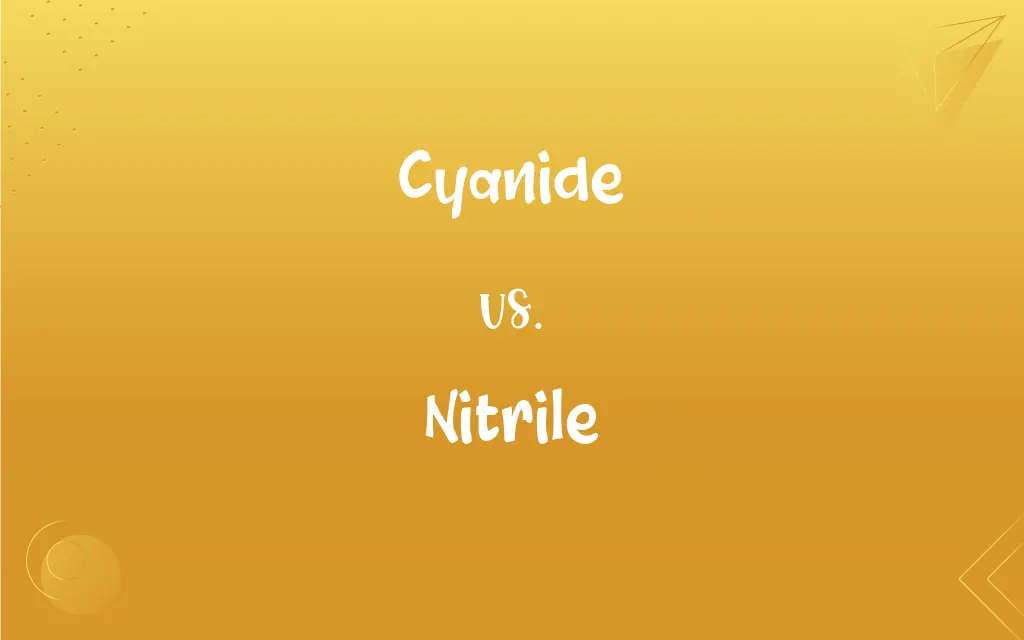Cyanide vs. Nitrile: What's the Difference?
Edited by Aimie Carlson || By Harlon Moss || Published on January 6, 2024
Cyanide is a highly toxic compound containing a carbon-nitrogen triple bond linked to a metal or hydrogen. Nitrile is an organic compound with a carbon-nitrogen triple bond, but part of a larger molecule.

Key Differences
Cyanide is a chemical compound known for its high toxicity, containing a carbon-nitrogen triple bond attached to a metal or hydrogen atom. Nitrile, on the other hand, is an organic compound with a similar carbon-nitrogen triple bond but integrated into a larger molecular structure.
Cyanides, like hydrogen cyanide and potassium cyanide, are lethal at low doses due to their ability to inhibit cellular respiration. Nitriles, such as acetonitrile, are less toxic and are used in industrial applications, including as solvents.
Cyanide ions are negatively charged (CN-), making them highly reactive. Nitriles contain the -C≡N functional group but are part of a larger, more stable molecule.
The use of cyanide is heavily regulated due to its toxicity, and it is found in some industrial processes and pesticides. Nitriles are more commonly encountered in everyday life, in products like nitrile rubber and pharmaceuticals.
In terms of chemical synthesis, cyanides are used in small quantities for specific reactions. Nitriles are used more broadly in organic chemistry for the synthesis of a variety of compounds.
ADVERTISEMENT
Comparison Chart
Chemical Structure
Carbon-nitrogen triple bond linked to a metal or hydrogen
Carbon-nitrogen triple bond part of a larger molecule
Toxicity
Highly toxic, lethal at low doses
Generally less toxic
Charge
Often negatively charged (CN-)
Neutral as part of a larger molecule
Common Uses
Industrial processes, pesticides
Solvents, nitrile rubber, pharmaceuticals
Stability
Highly reactive
More stable within a larger molecule
ADVERTISEMENT
Cyanide and Nitrile Definitions
Cyanide
Known for its ability to inhibit cellular respiration.
Cyanide poisoning occurs because it disrupts the body's oxygen utilization.
Nitrile
An organic compound with a carbon-nitrogen triple bond.
Acetonitrile is a common nitrile used as a solvent in laboratories.
Cyanide
Used in small quantities in chemical synthesis.
Certain organic reactions in the laboratory involve cyanide.
Nitrile
Less toxic than cyanide and used in industrial applications.
Nitrile gloves are popular in medical and chemical industries.
Cyanide
A toxic compound with a carbon-nitrogen triple bond.
The use of cyanide in gold mining is controversial due to its environmental impact.
Nitrile
Contains the -C≡N functional group.
Nitriles are important intermediates in organic chemistry.
Cyanide
Can be found in compounds like hydrogen cyanide.
Hydrogen cyanide is a colorless, highly poisonous gas.
Nitrile
Found in products like nitrile rubber and pharmaceuticals.
Nitrile rubber is used for making oil-resistant seals and hoses.
Cyanide
Heavily regulated due to its lethal nature.
Handling cyanide requires strict safety protocols.
Nitrile
More stable compared to cyanide compounds.
Nitriles are stable under conditions that would decompose cyanides.
Cyanide
The anionic univalent CN group, or any of various salts or esters of hydrogen cyanide containing a CN group, especially the extremely poisonous compounds potassium cyanide and sodium cyanide.
Nitrile
An organic molecule containing a CN group, an organic derivative of hydrocyanic acid.
Cyanide
To treat (a metal surface) with cyanide to produce a hard surface.
Nitrile
An oil-resistant copolymer of acrylonitrile and butadiene, used especially for disposable gloves, gaskets, seals, and tubing. Also called nitrile rubber.
Cyanide
To treat (an ore) with cyanide to extract gold or silver.
Nitrile
(organic chemistry) any of a class of organic compounds containing a cyano functional group -C≡N; they are named as derivatives of the appropriate carboxylic acid.
Cyanide
Any compound containing the -C≡N group or the CN− anion.
Nitrile
A type of synthetic rubber formed by the copolymerisation of acrylonitrile and butadiene.
Cyanide
(uncountable) Sodium or potassium cyanide, used in the extraction of gold and silver or as a poison.
Nitrile
Any one of a series of compounds bearing the cyanide radical (-CN); particularly, one of those cyanides of alcohol radicals which, by boiling with acids or alkalies, produce a carboxyl acid, with the elimination of the nitrogen as ammonia.
Cyanide
(uncountable) Hydrogen cyanide, or cyanide gas, a poisonous gas.
Nitrile
Any of a class of organic compounds containing the cyano radical -CN
Cyanide
(transitive) To treat or poison with cyanide.
Cyanide
A compound formed by the union of cyanogen with an element or radical.
Cyanide
Any of a class of organic compounds containing the cyano radical -CN
Cyanide
An extremely poisonous salt of hydrocyanic acid
FAQs
Are nitriles toxic like cyanides?
Nitriles are generally less toxic than cyanides and are used in various industrial applications.
What is a nitrile?
A nitrile is an organic compound containing a carbon-nitrogen triple bond as part of a larger molecule.
What are the uses of nitriles?
Nitriles are used in making nitrile rubber, solvents, and in the synthesis of pharmaceuticals.
What is cyanide?
Cyanide is a highly toxic compound with a carbon-nitrogen triple bond attached to a metal or hydrogen.
Why is cyanide so toxic?
Cyanide inhibits cellular respiration, preventing cells from using oxygen, which can be quickly lethal.
Can cyanide be found naturally?
Yes, cyanide compounds can be found in certain plants and seeds in small amounts.
Is nitrile rubber related to cyanide?
Nitrile rubber contains nitrile groups but is chemically different and much less toxic than cyanide.
How is cyanide used industrially?
Cyanide is used in gold mining, electroplating, and as a chemical intermediate.
Can cyanide be detected in the environment?
Yes, there are tests to detect cyanide in water and soil due to its environmental impact.
Are nitrile gloves made from cyanide?
No, nitrile gloves are made from synthetic rubber containing nitrile groups, not cyanide.
What precautions are needed when handling cyanide?
Strict safety protocols, including protective gear and proper ventilation, are essential when handling cyanide.
Are cyanide compounds stable?
Cyanide compounds can be unstable and highly reactive.
How are nitriles synthesized?
Nitriles are synthesized through various organic reactions, often involving ammonia derivatives.
How are cyanide and nitrile chemically different?
Cyanide is a simple ion or compound with a CN group, while nitrile is a more complex molecule containing a CN group.
Can nitriles be converted into other compounds?
Yes, nitriles can be chemically transformed into a variety of other organic compounds.
Is cyanide present in cigarette smoke?
Yes, small amounts of cyanide compounds can be found in cigarette smoke.
What industries use nitrile?
Nitrile is used in the chemical, automotive, and pharmaceutical industries, among others.
Can both cyanide and nitrile be found in a laboratory?
Yes, both can be found in a laboratory setting, but cyanide is handled with extreme caution due to its toxicity.
Can cyanide be used in medical applications?
Due to its toxicity, cyanide is not typically used in medical applications.
Is cyanide ever used in pharmaceuticals?
Cyanide is not used in pharmaceuticals due to its high toxicity.
About Author
Written by
Harlon MossHarlon is a seasoned quality moderator and accomplished content writer for Difference Wiki. An alumnus of the prestigious University of California, he earned his degree in Computer Science. Leveraging his academic background, Harlon brings a meticulous and informed perspective to his work, ensuring content accuracy and excellence.
Edited by
Aimie CarlsonAimie Carlson, holding a master's degree in English literature, is a fervent English language enthusiast. She lends her writing talents to Difference Wiki, a prominent website that specializes in comparisons, offering readers insightful analyses that both captivate and inform.






































































